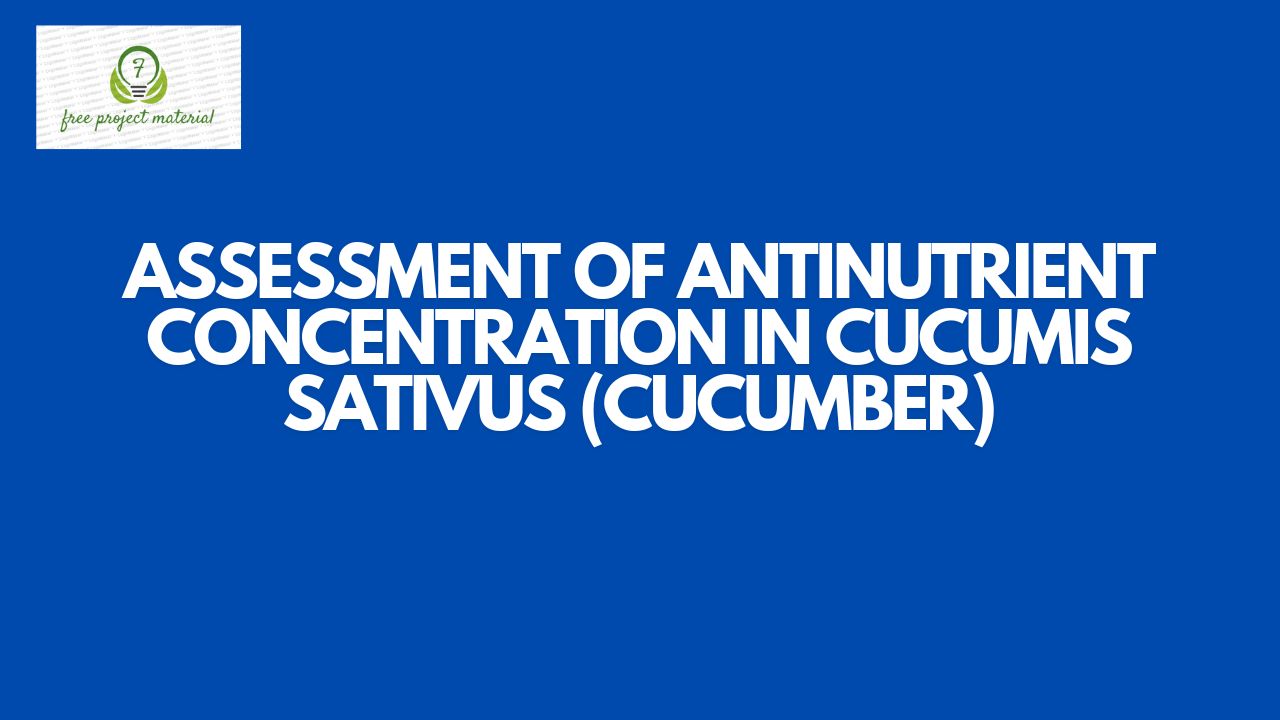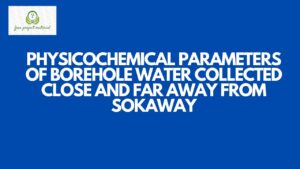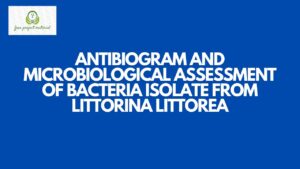ABSTRACT
The assessment of antinutrient concentration in cucumis sativus (cucumber) cultivated in Rafia farm was carried out using standard analytical procedures. The analyzed fruit revealed the presence of some appreciable amount of the toxicity properties such as oxalate (0.89 ± 0.098 mg/100g), tannins (3.29 ± 0.09 mg/100g), Phytate (0.04 ± 0.021 mg/100g), HCN (1.51 ± 0.042 mg/100g), and Saponins (2.56 ± 0.078%) respectively. The study revealed that tannins has the highest concentration in cucumber fruit and phytate was found to be the lowest from the result, the level of toxicity properties in cucumber fruit were found to be below the WHO stipulated standard.
TABLE OF CONTENTS
Title Page- – – – – – – – – i
Certification- – – – – – – – ii
Dedication- – – – – – – – – iii
Acknowledgments- – – – – – – iv
Abstract- – – – – – – – – v
Table of Contents- – – – – – – – vi-vii
CHAPTER ONE: INTRODUCTION
1.1 Background of the Study- – – – – – 1-3
1.2 Aim and Objectives of the Study- – – – – 3-4
1.2.1 Aim- – – – – – – – – – 3
1.2.2 Objectives- – – – – – – – – 4
1.3 Scope and Limitation of the Study- — – – – 4
CHAPTER TWO: LITERATURE REVIEW
2.1 Description of Cucumis sativus– – – – – 5
2.2 Nutritional and Chemical Constituents of Cucumis sativus– 5-6
2.3 Yield of Cucumis sativus– – – – – – 6-7
2.4 Medicinal Uses of Cucumis sativus– – – – – 7-11
2.5 Antinutrients in Plant-Based Foods- – – – – 11
2.5.1 Lectins- – – – – – – – – 11-13
2.5.2 Saponins- – – – – – – – – 13
2.5.3 Phytates- – – – – – – – – 13-14
2.5.4 Tannins- – – – – – – – – 14-15
2.5.5 Oxalates- – – – – – – – – 15-16
2.5.6 Exorphins- – – – – – – – – 16
2.6 Antinutrient and Human Health- – — – – 17-18
2.7 Disabling Antinutrient in Food- – – – – – 18-22
CHAPTER THREE: MATERIALS AND METHOD
3.1 Description of the Study Area- – – – – – 23
3.1.1 Location- – – – – – – – – 23
3.1.2 Climate- – – – – – – – – 23
3.1.3 Soil and Vegetation- – – – – – – 23-24
3.2 Materials and Reagents- – – – – – – 24
3.3 Sample Collection- – – – – – – 25
3.4 Sample Preparation- – – – – – – 25
3.5 Methods- – – – – – – – – 25-31
CHAPTER FOUR: RESULTS AND DISCUSSION
4.1 Results- – – – – – – – – 32
4.2 Discussion- – – – – – – – – 33-36
CHAPTER FIVE: CONCLUSION AND RECOMMENDATION
5.1 Conclusion- – – – – – – – – 37
5.2 Recommendation- – – – – – – – 37
References
CHAPTER ONE: INTRODUCTION
1.1 Background of the Study
Vegetables are parts of plants that are consumed by humans or other animals as food. The original meaning is still commonly used and is applied to plants collectively that are refer to all edible plant matter, including the flowers, fruits, stems, leaves, roots, and seeds. Cucumber (Cucumis sativus L.) is a widely cultivated plant and its belongs to the family Curcumbitaceae, and the kingdom plantae. It is a creeping vine that bears cucumiform fruits that are used as vegetables. The fruits are eaten raw with the seeds and peel. There are three main varieties of cucumber: slicing, pickling and seedless. Within these varieties, several cultivars have been created. In North America, the term ‘‘wild cucumber’’ refers to plants in the genera Echinocystis and Marah, but these are not closely related. The cucumber is originally from South Asia, but now grows on most continents. Many different types of cucumber are traded on the global market (Mariod et al., 2017).
There exist a vast array of biologically-active constituents in plants that potentiate danger to human and other animals. The awareness that these compounds have the ability to exert toxic and biological responses when ingested has called for urgent investigation, with a view to ascertain their activities in the biological systems (Igile, 1996). Natural substances of plant origin such as alkaloid, saponnins, tannins, oxalic acid, flavonoids, trypsin (protease), oxalates, phytates, haemagluttinins (lectins), cyanogenic glycosides, coumarins and gossypol have been proven active with enormous ability to elicit biological responses (Zenk, 1991). These molecules are responsible for whatever changes that occur biochemically, when these plant derivatives are ingested. Some of these metabolites are endowed with chelating ability. Tannins for example, a well-known antinutritional factor, water soluble phenolic compounds with a molecular weight greater than 500, with ability to precipitate proteins from aqueous solution by forming complexes and rendering them unavailable for digestion (Binta and Khetarpaul, 1997). The binding affinities of these bio-chemicals to divalent elements that are of physiologically importance form the basis of various metabolic disorders and malfunctions of the vital organs in vivo; Oxalate binds to calcium to form calcium oxalate crystals and equally impair the absorption and utilization of calcium in the body resulting to disease conditions; ricket and Osteomalacia and renal stones (Ladeji et al., 2004).
Aletor and Adeogun (1995) reported that some anti-nutritonal phytochemicals exhibit protective effects, thus making them to serve a dual purposes of reducing some essential nutrients and protecting the body against a number of biochemical, Physiological and metabolic disorders. The bio-unavailability of most mineral elements mediated by antinutrients in vivo has already been established by Akindahunsi and Slawu (2005). Thus, antinutrients are natural or synthetic compounds that interfere with the absorption of nutrients (Oxford dictionary of Biochemical and molecular biology, 2006).
1.2 Aim and Objectives of the Study
1.2.1 Aim
The aim of this study is to assessed the antinutrient concentration of Cucumis sativus cultivated in Raffia farm.
1.2.2 Objectives
The objectives of this study is;
- To determine the antinutrient concentration in Cucumis sativus cultivated in raffia farm.
- To compare the results with the permissible standard of WHO
- And make useful recommendation base on the result of this study.
1.3 Scope and Limitation of the Study
This study will only cover the antinutrient concentration in Cucumis sativus (cucumber), and this research is limited due to financial and time constraint.


